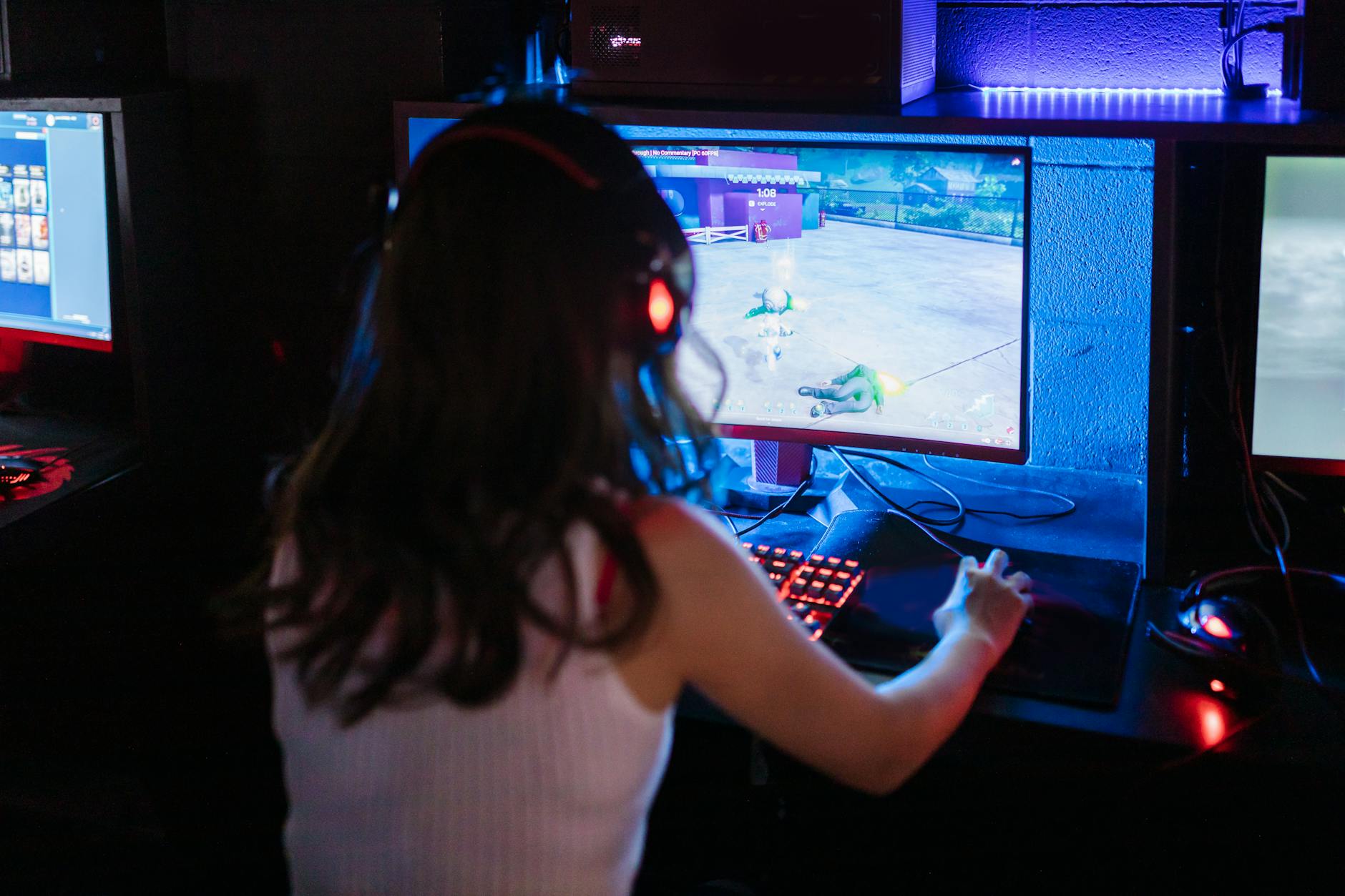Understanding Refresh Rates: What They Mean for Your Vision
When you stare at a screen for hours, have you ever felt your eyes getting tired, dry, or even a little blurry? That might not just be because of screen time—it could be your monitor’s refresh rate. Refresh rate, measured in Hertz (Hz), refers to how many times per second your screen updates with a new image. The higher the refresh rate, the smoother the motion appears. But did you know that a low refresh rate can strain your eyes, making gaming or working less comfortable?
Many standard monitors run at 60Hz, meaning they refresh 60 times per second. This is fine for casual browsing, but for intense gaming or long hours of screen use, it may cause discomfort. Higher refresh rates, like 120Hz, 144Hz, or even 240Hz, make movements on screen look smoother, reducing flickering and minimizing strain on your eyes. If you’ve ever felt like your eyes were working overtime while playing your favorite game, your refresh rate could be to blame!
The Connection Between Low Refresh Rates and Eye Strain
Ever noticed how older monitors sometimes have a subtle flicker that makes your eyes feel weird after a while? That’s because when a refresh rate is too low, the screen struggles to keep up with the motion, leading to a choppy experience. Your eyes must work harder to compensate for this, which can cause fatigue, dryness, and even headaches.
When gaming, especially in fast-paced scenarios, a low refresh rate can make everything look jittery and less fluid. Your eyes constantly try to track fast-moving objects, but if the refresh rate isn’t high enough, it creates a disjointed experience, forcing your vision to work harder. Over time, this effort leads to digital eye strain, making your eyes feel heavy, tired, or irritated.
Switching to a higher refresh rate monitor can significantly reduce this strain. Monitors with 120Hz or higher ensure that movements appear seamless, reducing the burden on your eyes. So, if you’re someone who games for long hours, upgrading your monitor can make a noticeable difference in how comfortable your eyes feel after an intense session.
How to Optimize Your Monitor Settings for Eye Comfort
You don’t necessarily have to buy an expensive 240Hz monitor to reduce eye strain. While a high refresh rate helps, adjusting your display settings can also make a huge difference. One of the best things you can do is enable your monitor’s “eye comfort” or “low blue light” mode, which reduces the amount of blue light emitted from the screen. Blue light has been linked to eye fatigue and sleep disruption, so turning it down can help your eyes feel less tired.
Another setting to pay attention to is brightness. A screen that’s too bright or too dim forces your eyes to work harder. Aim for a brightness level that matches the lighting in your room. If you’re gaming in a dark room, turn the brightness down slightly, but if you’re in a well-lit space, make sure your screen isn’t too dim.
Refresh rates are also something you can adjust. If your monitor supports higher refresh rates, make sure it’s set to the maximum available option in your computer’s display settings. Some monitors default to a lower setting, so manually increasing it can instantly improve your viewing experience. Also, don’t forget to adjust the contrast and sharpness to reduce unnecessary strain—overly sharp images can sometimes make text and UI elements harder to read.

Why Proper Lighting Matters for Gamers
When you spend hours immersed in gaming, the right lighting setup can make a world of difference. Poor lighting can strain your eyes, cause headaches, and even reduce your reaction time in fast-paced games. A well-lit gaming space helps you stay focused, comfortable, and alert while protecting your eyes from unnecessary strain. By setting up your room properly, you can create a more enjoyable and healthier gaming environment.
The Danger of Screen Glare & How to Fix It
Glare is one of the biggest culprits behind eye strain, and it usually comes from improper lighting placement. If you have a bright light source reflecting off your screen, it forces your eyes to work harder to focus, leading to discomfort and fatigue. To minimize glare, position your monitor so that no direct light hits the screen. Use indirect lighting, such as LED strips behind your monitor, to create a soft glow that enhances visibility without causing harsh reflections.
Choosing the Right Light Temperature
Not all light is created equal, and the temperature of your lighting plays a huge role in eye comfort. Cool white and blue-toned lights can be harsh on your eyes, especially during long gaming sessions. Instead, opt for warm or neutral lighting that mimics natural daylight. Smart bulbs with adjustable color temperatures are a great investment, allowing you to switch between bright, energizing light during the day and softer, relaxing light at night to help your eyes adjust more comfortably.
Ambient vs. Task Lighting – Finding the Balance
A common mistake gamers make is either playing in total darkness or relying solely on bright overhead lights. Neither is ideal for long-term eye health. A mix of ambient and task lighting is the best approach. Ambient lighting provides a general glow that reduces contrast between your screen and surroundings, preventing eye fatigue. Task lighting, such as a small desk lamp with a soft bulb, gives you focused light for other activities like reading or adjusting your setup.
Blue Light & Eye Protection
Your gaming monitor already emits blue light, which can disrupt sleep patterns and contribute to digital eye strain. While blue light blocking glasses can help reduce this effect, adjusting your room lighting also makes a big difference. Use warm or amber-toned lights in the evening to counteract blue light exposure, and consider installing bias lighting behind your monitor to create a balanced viewing experience that minimizes strain.
Blue Light Filtering Efficiency – The Core Feature
Not all blue light lenses are created equal, and the level of blue light filtering varies significantly. Some glasses filter as little as 20% of blue light, while high-performance gaming glasses can block up to 90% of harmful rays. Ideally, you want lenses that strike a balance—blocking enough blue light to reduce eye strain without distorting your color perception. Look for lenses with a filtering range between 50% and 80% to protect your eyes while keeping your game visuals crisp and accurate.
Lens Tint – Clear vs. Amber vs. Yellow
Lens color isn’t just for style—it plays a crucial role in how much blue light gets blocked. Clear lenses typically block the least amount of blue light but are great for everyday use. Amber and yellow-tinted lenses are more effective at blocking blue light, making them perfect for long gaming marathons. However, if you do a lot of color-sensitive work (like video editing or graphic design), clear or slightly tinted lenses may be the better option. Choose based on your balance between gaming performance and real-world usability.
Anti-Glare Coating – Reduce Eye Fatigue
Glare from your screen can be just as harmful as blue light itself. A good pair of gaming glasses should include an anti-glare coating to minimize reflections, improve contrast, and enhance visual clarity. This feature is particularly helpful in darker gaming environments where bright screens can strain your eyes. Plus, reducing glare helps you maintain focus, especially in fast-paced competitive gaming where every millisecond counts.
Can Gaming Glasses Boost Your Reaction Time?
If you’re a gamer, you know that split-second reactions can mean the difference between victory and defeat. Whether you’re dodging an enemy attack or making a precise shot, your vision plays a huge role in how quickly you respond. But what if your screen is actually working against you? The blue light emitted from digital screens can cause eye strain, fatigue, and even slow down your reaction time. That’s where gaming glasses come in. But do they actually make a difference in performance? Let’s dive into the science and find out.
The Impact of Blue Light on Your Eyes
Gaming for hours means constant exposure to artificial blue light, which can lead to digital eye strain. This strain can make your eyes feel dry, irritated, and fatigued—making it harder to focus. When your eyes are tired, your brain takes longer to process visuals, ultimately affecting your reaction time. Blue light glasses benefits include reducing this strain by filtering out harmful wavelengths, keeping your eyes comfortable and alert for longer gaming sessions. Less strain means quicker response times and sharper focus when it matters most.
How Gaming Glasses Help Sharpen Your Reflexes
Gaming glasses aren’t just about reducing discomfort—they actively enhance visual clarity. Many high-quality gaming glasses come with anti-glare coatings and contrast-enhancing lenses, which make it easier to see small details on the screen. When your vision is clear and free of distractions, your brain processes images faster. This means that when an opponent appears on screen, your eyes register them quickly, and your hands can react instantly. With blue light glasses benefits like better focus and sharper visuals, your gaming performance gets a natural boost.
Reducing Fatigue for Longer, More Effective Gaming
Another factor that slows down reaction time is fatigue. After hours of intense gaming, your eyes start to struggle, leading to slower response times. Gaming glasses help combat this by reducing the strain caused by prolonged exposure to screens. They work by balancing the light entering your eyes, preventing overexposure to harsh blue light. This means you can play longer without feeling the usual exhaustion that sets in after a marathon gaming session. Less fatigue equals better reactions, and better reactions mean more wins.
Are Gaming Glasses Worth It for Competitive Play?
For casual gamers, the difference might not be as noticeable, but for competitive players, every millisecond matters. Professional eSports athletes constantly look for ways to optimize their performance, and many rely on gaming glasses to keep their vision sharp during tournaments. By reducing distractions like glare and fatigue, gaming glasses ensure that your focus stays razor-sharp. If you’re serious about improving your reaction time and gaining a competitive edge, investing in a quality pair of blue light blocking glasses could be a game-changer.

